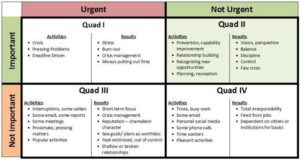
In our work with business owners and senior leaders, we find that they are often stuck in the “Tyranny of the Urgent.” As a result, leaders spend considerable time running from one “emergency” to another. Sound familiar?
Urgent vs. Important
Some of you will recall Covey’s quadrant on Urgent vs. Important (see diagram below).[1] Interestingly, it was adapted from President Dwight D. Eisenhower’s “Eisenhower Matrix.” President Eisenhower said:
“What is important is seldom urgent, and what is urgent is seldom important.”[2]

-
Important:
- Work and related tasks contributing to the mission, value, and goal of the organization. These tend to be longer-term tasks, such as planning and disciplined investment in what’s important.
- Because it isn’t urgent now, we tend to put them off.
-
Urgent:
- On the other hand, urgent, are tasks needing immediate action, like putting out fires and handling unexpected emergencies.
- Often times, the urgent involves someone or something clamoring for your attention, important and not important. Hence, the tyranny of the urgent.
In the every day of business, there are an array of urgent matters that come up. If we are not strategic in the use of our time and resources, there is little time or energy left to focus on what is important. Days and weeks slip by without the important being addressed…until it is an emergency.
Working In the Business:
Working IN the business often equates to dealing with urgent matters and other day-to-day challenges. Yes, these are important. However, if we are not strategic with our time, there is little, or no time left to work on the business.
Working On the Business:
Working ON the business includes setting goals, engaging in strategic thinking about critical success factors, paying attention to trends that could represent opportunity or threats, developing new products or services, ensuring the financial health, and monitoring actions by the competition.
If you find yourself trapped in the tyranny of the urgent, consider these action steps:
- Turn Goals into Tasks, such as create a To Do List: plan work to free mind and place priorities
- Complete Before Adding More Tasks; Limit 7 tasks per quadrant, before adding new tasks focus on finishing present tasks
- Limit Personal Silos by having a task list that includes family and business in one list. Allowing priorities to be well rounded and fulfilling.
- Resist Emergency Mode
- Do not let others distract you from predefined priorities. Distractions rob Production
- Resist the desire to respond immediately to the unexpected and instead shift schedule at an appropriate time to address requests.
- Schedule Breaks
- Limit burn out and procrastination habits through allotting personal breaks and rewards.[3]
We often find in coaching CEOs and others, it is important to intentionally block out time for them to work on important tasks. Additionally, when a client says they will do some follow up, they know we will ask about progress at the next coaching session. This accountability helps leaders get things done when they might not otherwise.
For the Faith-Based Reader:
Consider Luke 12:42-48, a part of which says, “Who then is the faithful and wise manager… blessed is that servant whom his master will find so doing when he comes.” The biblical principle is this: As you are faithful with a little, you can be entrusted with more.
Reflection:
- What speaks to you in this article?
- Where do you struggle in balancing the tyranny of the urgent with focusing on the important?
- Who do you trust to speak truth into your life and/or hold you accountable for addressing the important?
[1] https://www.businessinsider.com/how-to-use-stephen-coveys-time-management-matrix-2015-12
[2] https://medium.com/the-mission/the-eisenhower-method-for-taking-action-how-to-distinguish-between-urgent-and-important-tasks-895339a13dea
[3] https://www.forbes.com/sites/briannawiest/2018/07/06/if-youre-on-the-cusp-of-burnout-here-are-6-things-you-can-do-to-save-your-career/#46ad334c5924